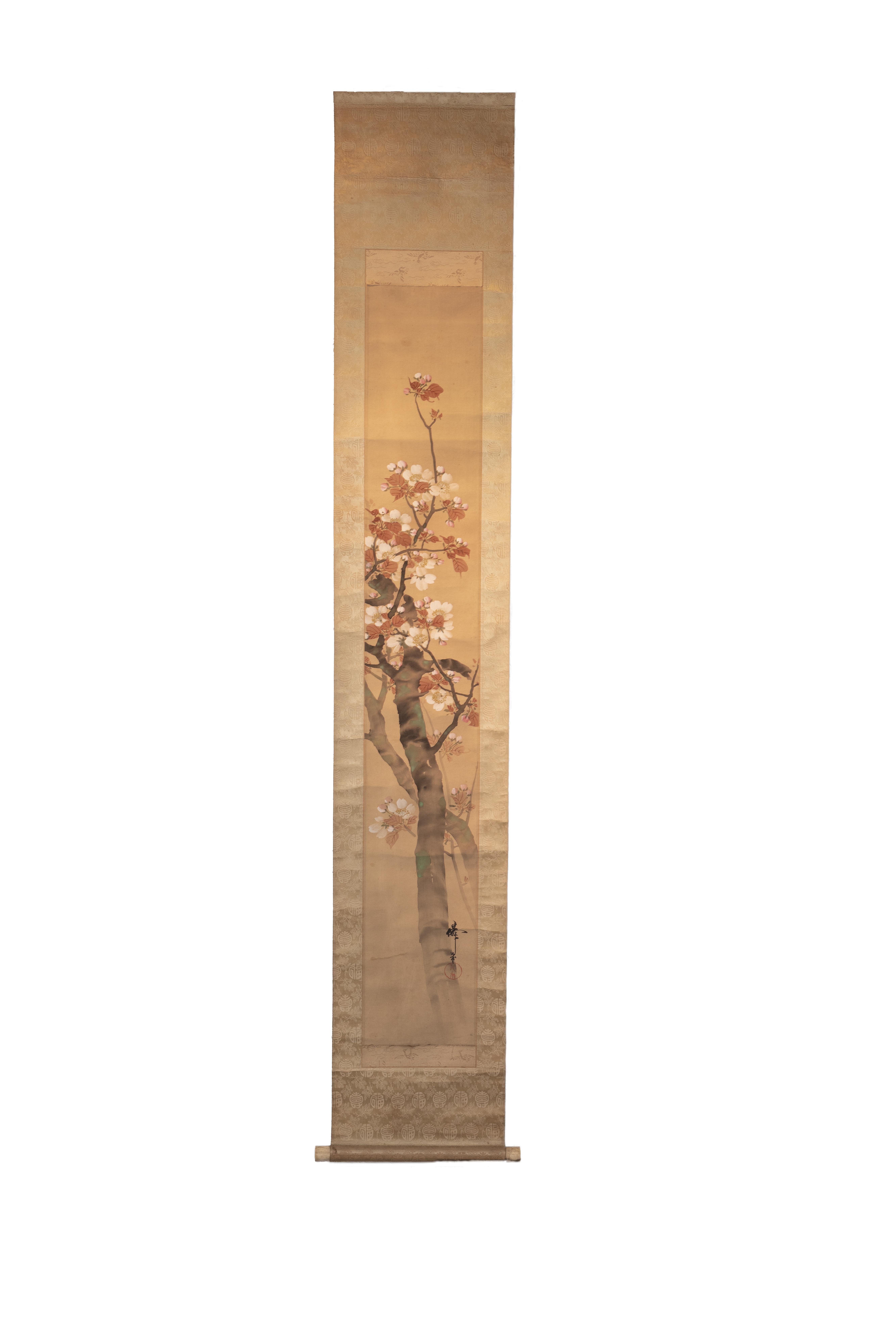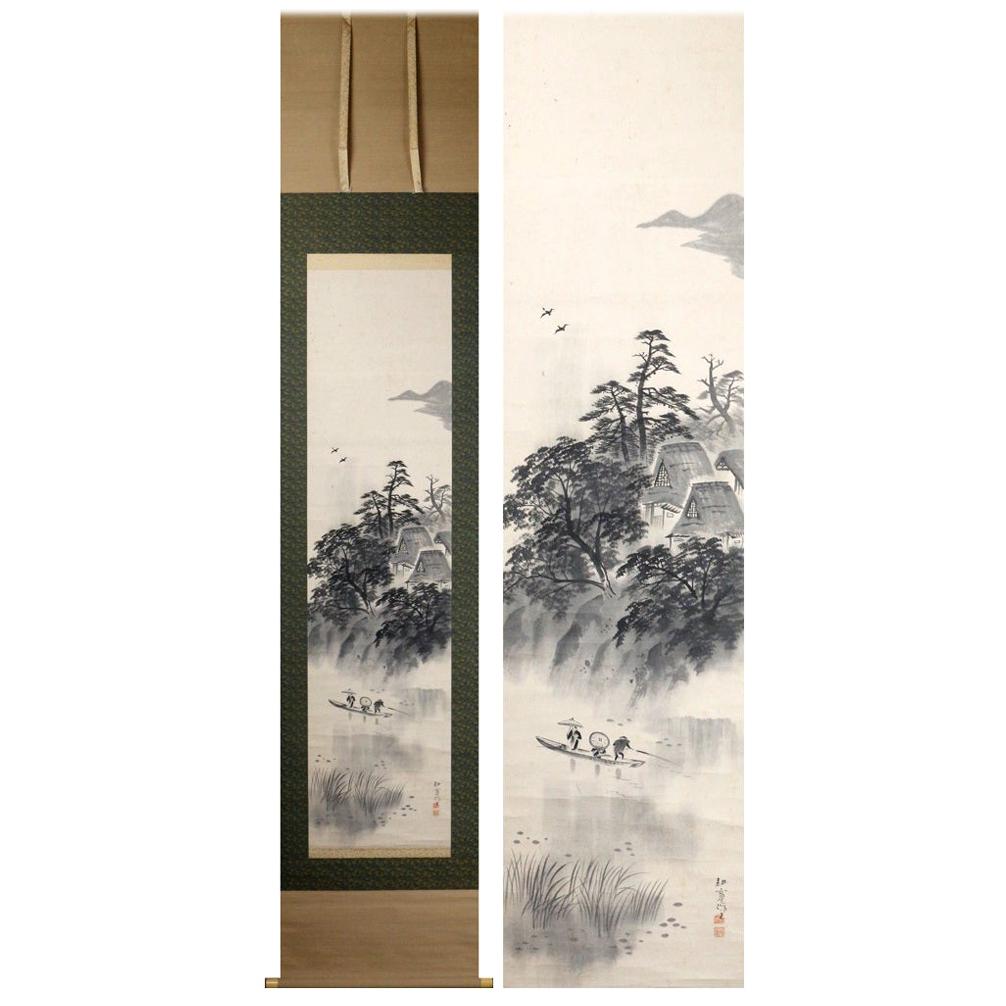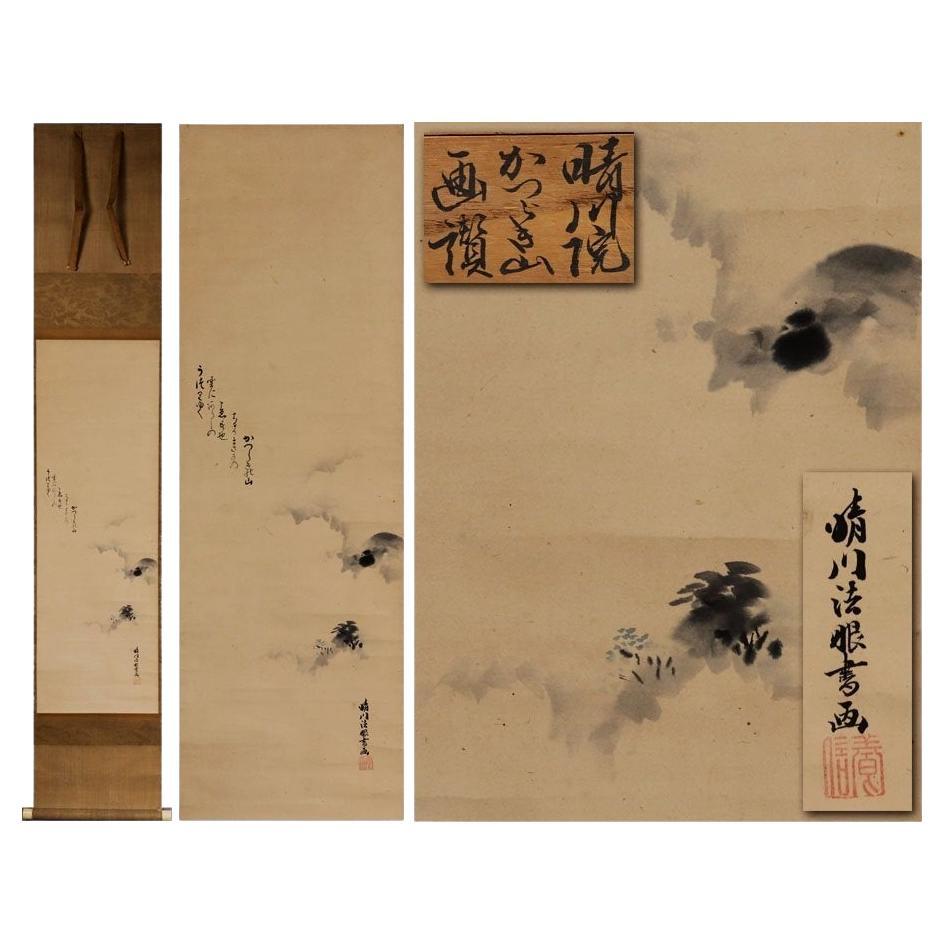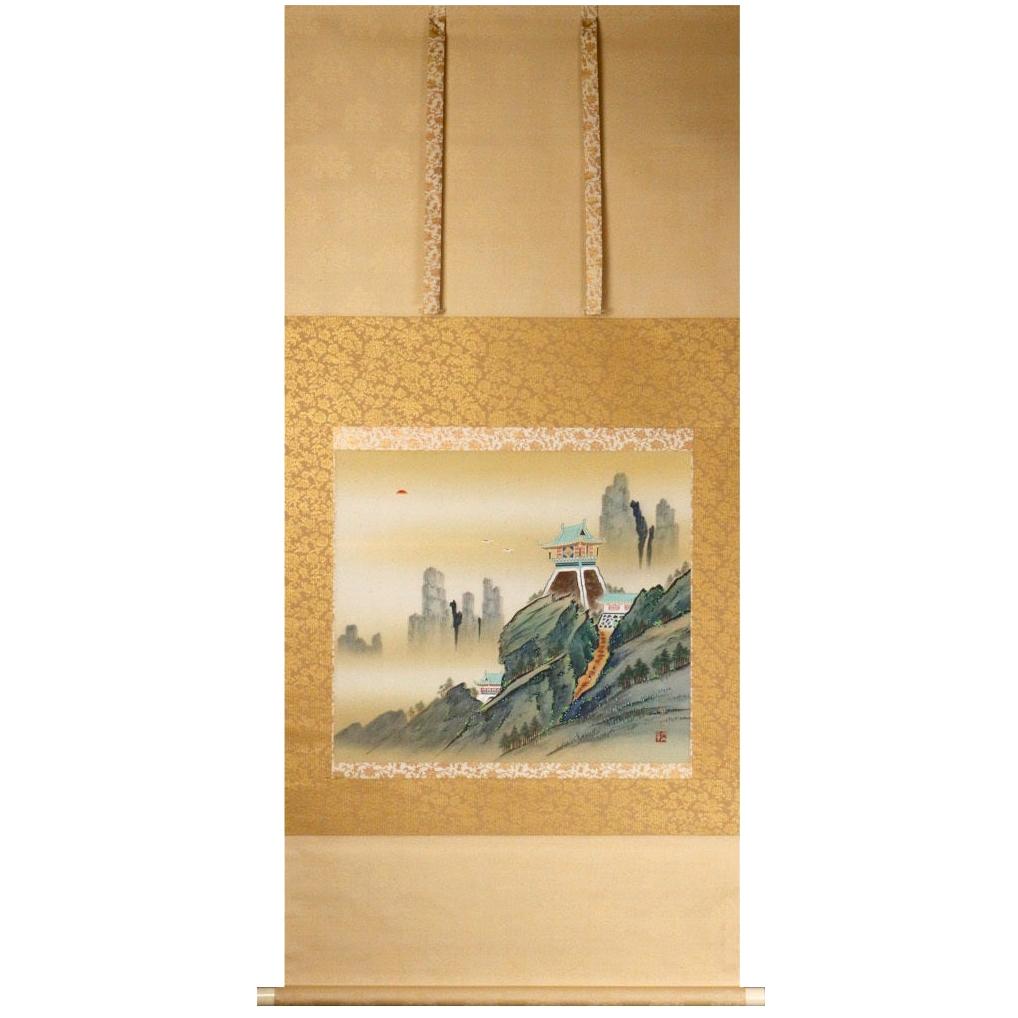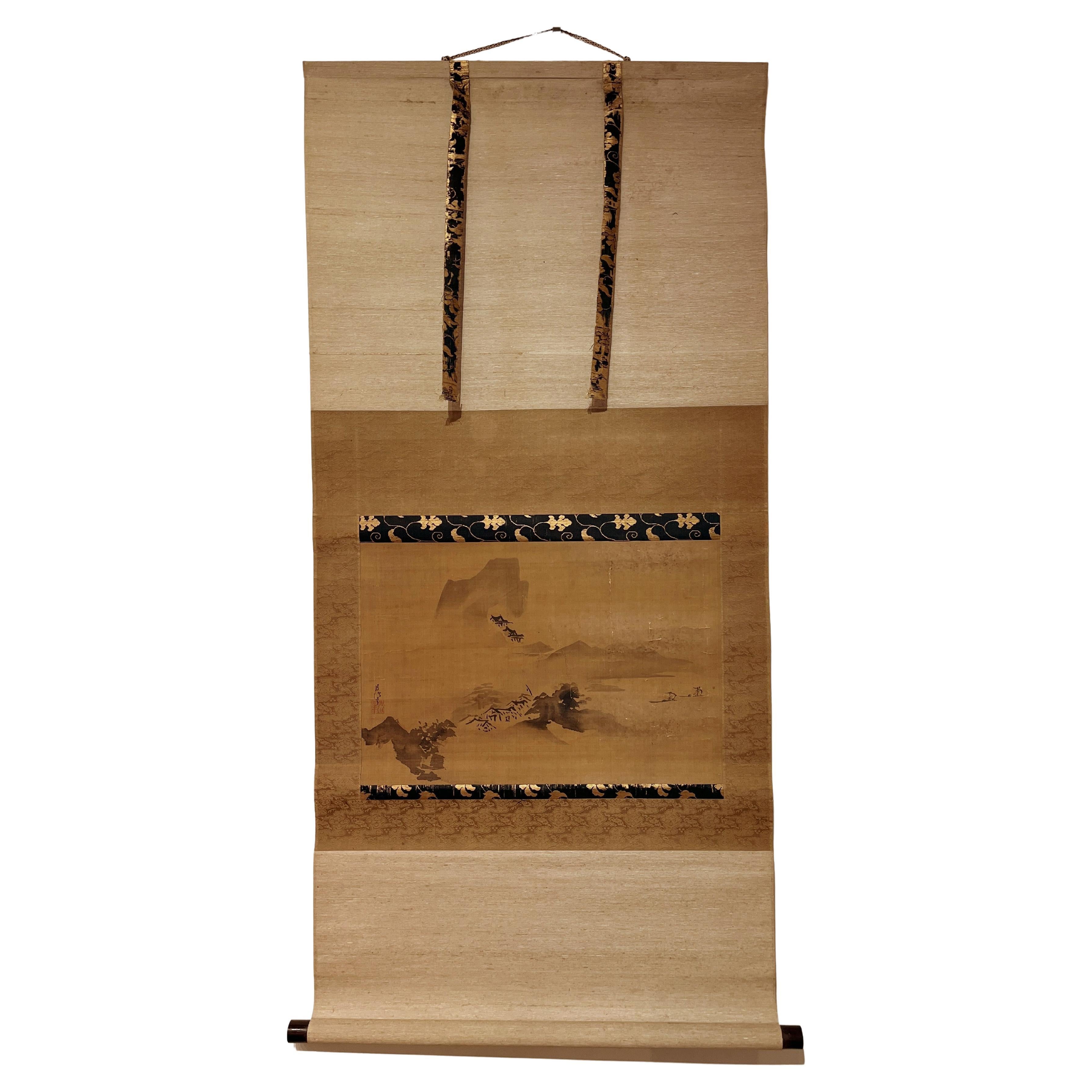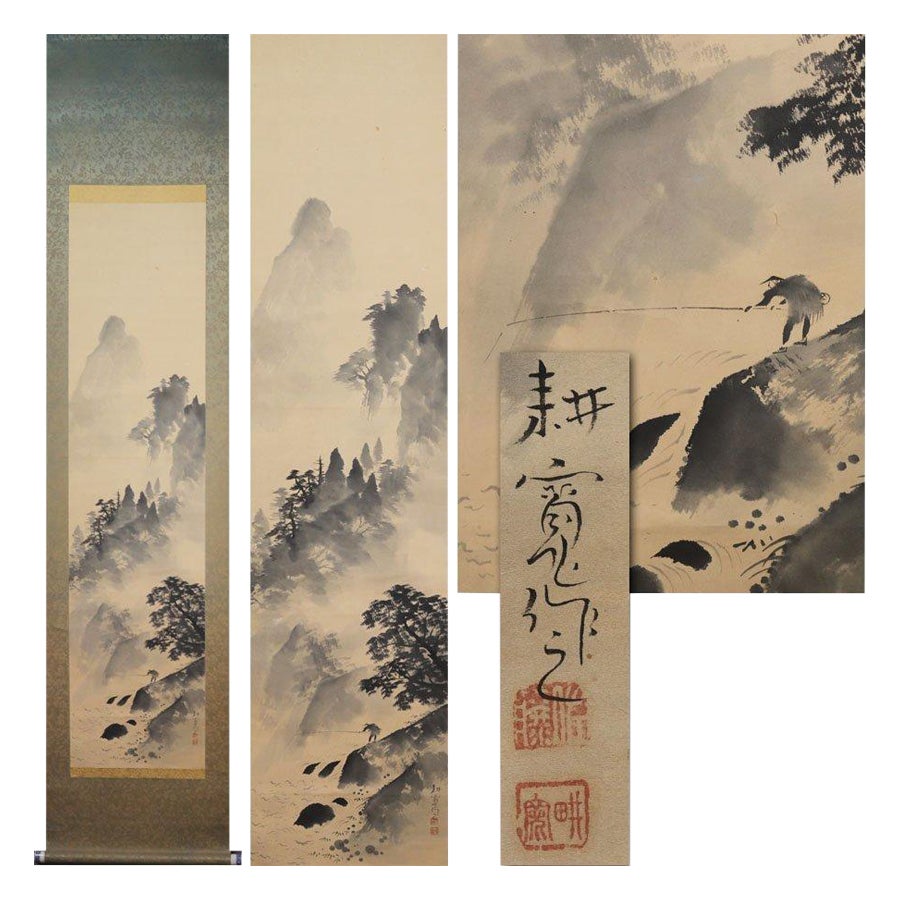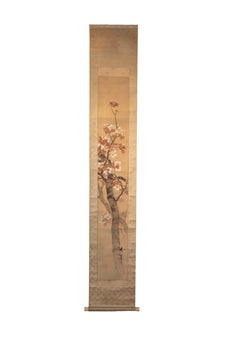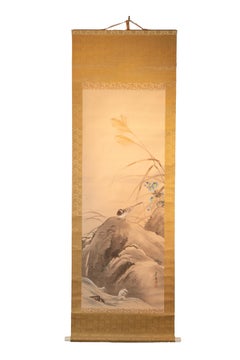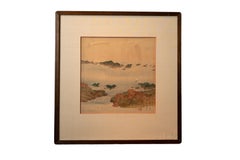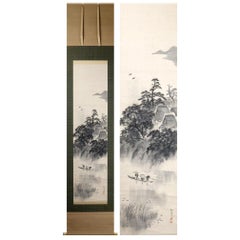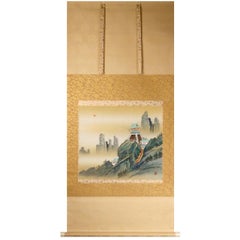Items Similar to 'Foggy Mountain', by Unknown, Japanese Antique Scroll
Video Loading
Want more images or videos?
Request additional images or videos from the seller
1 of 14
Unknown'Foggy Mountain', by Unknown, Japanese Antique Scroll
$280
$35020% Off
£217.05
£271.3220% Off
€245.69
€307.1120% Off
CA$400.74
CA$500.9220% Off
A$437.30
A$546.6220% Off
CHF 226.98
CHF 283.7320% Off
MX$5,231.88
MX$6,539.8520% Off
NOK 2,881.13
NOK 3,601.4220% Off
SEK 2,698.72
SEK 3,373.4020% Off
DKK 1,835.21
DKK 2,294.0120% Off
About the Item
This 77" x 22" Japanese Antique Scroll depicts a serene and foggy landscape painting on silk with a figure positioned in the lower half of the composition. The figure stands on what appears to be a raft or a bridge upon a body of water and holds an elongated tool, perhaps a spear for fishing. A tree emerges from the lower left hand corner of the work and slightly covers the visibility of the long raft that the figure stands upon. The tree, just like the rest of the work, is represented in a painterly style, with light, simple and undefined strokes. The branches are brown, thin strokes and the leaves are small, fanned out strokes that are not connected to the branches or each other and are white and orange/brown. A very faint mountain is depicted emerging from the left hand side of the scroll. The base of the mountain starts from about the halfway mark of the composition, slightly above the figure on the raft, with the point reaching just below the top of the scroll. The base of the mountain has discernible trees as well as on the whole mountain, and their representations begin to get smaller and smaller and eventually disappear toward the mountaintop. The mountain and trees are slightly hidden by the dense fog depicted in the scene, making the subject matter less visible, especially towards the top of the composition and around the mountain. There are some thicker/larger brush strokes portrayed on the mountain, creating areas that seem to be very dense parts of the landscape. There are also visible structures that reside on the mountain, specifically two, that fall about halfway from the base of the mountain to the top. The structures resemble traditional Japanese architecture and are painted gold, making them stand out from the earth tones used to paint the mountain and trees surrounding the structures.
Predominant colors are grey, greens, white and flecks of aqua throughout. The watercolor scene is bordered by pale green silk fabric with a pattern of organic lines throughout the border, framing the piece along with adding texture. The traditional styles of Japanese scrolls are paper upon silk. This hanging scroll's mounting style is specifically known as the "Sansebiao" style. The painting made on paper, is known as "huaxin" (畫心; "painted heart"), and within the silk border of the work, the upper part is called tiantou (天頭; "Heaven") while the lower part is called ditou (地頭; "Earth"). Above the tiantou, at the very top of the scroll is a thin wooden bar, called tiangan (天杆) and there is a plastic ivory cylindrical bar at the bottom of this scroll, called a digan (地杆), which is attached to give the scroll weight at the bottom as that it hangs properly onto a wall, but it also acts as a base to roll up a scroll for storage when the artwork is not in display. According to Anna Willmann, from the Department of Asian Art, The Metropolitan Museum of Art, "It is believed that the handscroll was invented in India sometime before the fourth century B.C., where it was primarily used for religious texts, and came to China by the first century A.D. The introduction of the handscroll to Japan came several centuries later, as part of the spread of Buddhism from the mainland around the sixth century, along with many other cultural innovations, including the Chinese writing system. The earliest extant illustrated handscroll in Japan is a work showing episodes from the life of the Buddha, and was created in the eighth century."
- Dimensions:Height: 77 in (195.58 cm)Width: 22 in (55.88 cm)
- Medium:
- Movement & Style:
- Period:
- Condition:
- Gallery Location:Oklahoma City, OK
- Reference Number:Seller: F2D00311stDibs: LU1441213328992
About the Seller
5.0
Gold Seller
Premium sellers maintaining a 4.3+ rating and 24-hour response times
Established in 2019
1stDibs seller since 2020
89 sales on 1stDibs
Typical response time: <1 hour
- ShippingRetrieving quote...Shipping from: Oklahoma City, OK
- Return Policy
More From This Seller
View All'Dogwood Tree', By Unknown, Japanese Antique Scroll
Located in Oklahoma City, OK
This Antique Japanese Scroll is a depiction of a dogwood tree. Painted in a traditional Japanese style with watercolor, the brush strokes are ...
Category
20th Century Edo More Art
Materials
Silk, Paper, Watercolor
$240 Sale Price
20% Off
'Bird on Rock with Blue Flowers', By Unknown, Chinese Antique Scroll
Located in Oklahoma City, OK
This 59" x 20" Chinese Antique Scroll depicts a simple yet serene scene of a bird on a rock. The bird stands on the rock, which is much larger in size in comparison to the bird. The ...
Category
Late 18th Century Qing More Art
Materials
Silk, Paper, Watercolor
$140 Sale Price
20% Off
'Chinese Mountain Scene, ' by Unknown, Watercolor on Silk Painting
Located in Oklahoma City, OK
This framed 24" x 23" watercolor on silk by an Unknown Chinese artist depicts a coastal mountain landscape. This work features several mountain clus...
Category
Late 19th Century Other Art Style Landscape Drawings and Watercolors
Materials
Silk, Watercolor
$960 Sale Price
20% Off
'Japanese Woodblock Print', By Unknown, Color Woodblock Print on Paper
Located in Oklahoma City, OK
This 21.25" x 37.5" framed Japanese woodblock print, depicts a busy scene that includes many figures within, and upon a large boat. The boat takes up the majority of the horizontal c...
Category
19th Century Edo More Prints
Materials
Paper, Woodcut
$520 Sale Price
20% Off
'Cloud Bank, ' by Marc Barker, Oil on Panel Painting
Located in Oklahoma City, OK
This 12" x 24" horizontal painting by Marc Barker captures floating cumulus clouds in a monochromatic palette. The expertly painted clouds form a line over...
Category
2010s Contemporary Landscape Paintings
Materials
Oil, Board
'Rona Bots: Gold Edition, ' by XVALA, Silkscreen, Oil Stick, Iridescent Painting
By XVALA
Located in Oklahoma City, OK
This large scale 66" x 94" mixed media painting by XVALA is from his "Pandemic Collection: Series #9." The background is painted an iridescent gold with three alien "Rona Bots" weari...
Category
2010s Contemporary Figurative Paintings
Materials
Paint, Canvas, Screen
$8,064 Sale Price
20% Off
You May Also Like
Mountain Scene Showa Period Scroll Japan 20c Artist Kohiro Sato Nihonga Style
Located in Amsterdam, Noord Holland
As you can see, it is a work drawn by Kohiro Sato. It is a simple but unique presence of a river boat, and it is a very tasty work combined with the scenery reflected on the surface ...
Category
20th Century Japanese Showa Paintings and Screens
Materials
Silk
$1,214 Sale Price
20% Off
Lovely Japanese 18/19th c Edo Scroll Kano Osanobu Nihonga Painting Mountain
Located in Amsterdam, Noord Holland
Kano Osanobu (狩野養信)
Osanobu Kano (born August 18, 1796; died June 12, 1846) was the ninth painter of the Kobikicho Kano School in the Edo period. His common name was Shozaburo. His father was Naganobu KANO, and Tadanobu KANO was his son. His Go (pen name) was Osanobu Seisenin, Kaishinsai, and Gyokusen.
Brief Personal History
He was born the eldest son of Naganobu ISENIN during the Edo period. He was first sent to serve at Edo Castle at the age of 15, and it appears that he was apparently pushed by his father to perform various public tasks for the Kanon School. He kept a diary for 36 years, starting from the day before he first went into service at Edo Castle until the day before he died. The diary is entitles "Official Service Diary" (it consists of 52 volumes that are maintained at the Tokyo National Museum, and 4 volumes that are separately maintained at the different families), and have become the focus of a lot of attention in recent years for the detailed information they present on the daily life and work of a prestigious official painter. The reading of the characters of his name was originally "Takenobu"; however, with the birth of the first son of the Shongun Ieyoshi TOKUGAWA in 1813, whose name was Takechiyo, having a sylable with the same pronunciation of "Take"was deemed to be inappropriate, and was therefore changed to "Osanobu". Because Takenobu died the following year, after which he was referred to as Gyokujuin, Osanobu changed his pen name Gyokusen he had used until that point to Seisenin, in order to avoid using the same Chinese charcter pronounced alike. In 1819, he attained the second highest rank for a Buddhist priest, Hogen, and assumed the role of head of the family after his father passed away in 1828. In 1834 he attained the highest rank for a Buddhist priest, Hoin. He oversaw the rennovation of the wall paintings of Nishinomaru Palace of Edo Castle from 1838 to 1839, and Honmaru Palace of it from 1844 to 1846. It is thought that Osanobu later died due to the fatigue...
Category
Antique 18th Century Edo Paintings
Materials
Silk
$1,705 Sale Price
20% Off
Mountain Scene Showa Period Scroll Japan 20c Artist Kazuhide Saiuchi Nihonga St
Located in Amsterdam, Noord Holland
As you can see, this work was drawn by Kazuhide Sainai, who is known as a Japanese-style painter.
The "Horaiyama-zu" is a very tasty view of trees, rocks, and mountains in the dista...
Category
20th Century Japanese Showa Paintings and Screens
Materials
Silk
$1,214 Sale Price
20% Off
Japanese Painting of Mountain and village, Hanging Scroll
Located in Greenwich, CT
Japanese scroll painting depicted village in the mountain
Ink and paper. Artist signed
Overall size: 43" height. 21" width
Image size: 10.8" height. 16" width
I am planning to re...
Category
Vintage 1940s Japanese Paintings and Screens
Materials
Paper
$600 Sale Price
29% Off
Japanese Painting 20th Scroll by Kouhiro Sato Nihonga Landscape Mountain Fishing
Located in Amsterdam, Noord Holland
This lovely painting depicts an angler fishing deep in the mountains, deep in the fresh greenery of a mountain gorge,
listening to the sound of the muddy waters of a river with a lar...
Category
20th Century Paintings
Materials
Silk
$937 Sale Price
20% Off
Japanese Meiji Riverside Scroll Painting, c. 1900
Located in Chicago, IL
Although western painting was initially embraced during Japan’s Meiji period (1868-1912), artists brought on a revival of traditional painting styles as they sought to create a modern Japanese style with roots in the past. This exquisite hanging scroll demonstrates the preference for soft layering of gray tones with judicious use of color. The landscape is rendered in soft ink washes that subtly distinguish between water, mountain, and sky. The scroll painting...
Category
Early 20th Century Japanese Meiji Paintings and Screens
Materials
Paper
More Ways To Browse
Antique Scroll
Scrolls Art
Silk Japanese Scrolls
Antique Japanese Scrolls
Hanging Scrolls
Cylinder Bar
Tree Of Life Wall Hanging
19th Century Chinese Painting On Silk
19th Century Japanese Scroll
Foggy Landscape
Japanese Paper Scroll
Japanese Art Mountains
Fishing Spears
Japanese Mountain Scrolls
Chinese Green Silk Wall Hanging
Bruce King
Calder Scarf
Carol Craig
